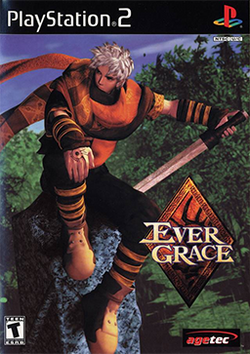Software:Evergrace
| Evergrace | |
|---|---|
 North American cover art | |
| Developer(s) | FromSoftware |
| Publisher(s) | |
| Director(s) | Yuzo Kojima |
| Producer(s) | Masanori Takeuchi |
| Programmer(s) | Kiwamu Takahashi |
| Artist(s) | Junichiro Ishino |
| Writer(s) | Masanori Takeuchi |
| Composer(s) | Kota Hoshino |
| Platform(s) | PlayStation 2 |
| Release | |
| Genre(s) | Action role-playing |
| Mode(s) | Single-player |
Lua error in Module:Lang/utilities at line 332: attempt to call field '_transl' (a nil value). is a 2000 action role-playing game developed by FromSoftware for the PlayStation 2 (PS2). It was released in Japan in April 2000 by FromSoftware, North America by Agetec in October 2000 as a launch title for the PS2 in the region and PAL territories in January 2001 by Ubisoft and Crave Entertainment.[1]
IGN gave some praise to the game for its innovations at the time, including its full use of the DualShock 2 controller's buttons and the unique "paper doll" system in which the player's avatar actually visibly wears the armor and clothing assigned to it.[4] But the website said most aspects of the game were fairly "run-of-the-mill" without being egregiously bad. GameSpot criticized the game for its dated visuals and laggy gameplay during battles. The website said that the interesting features do not overshadow the fact that the "core gameplay is awkward and uninteresting".[5]
Gameplay
Evergrace features two main characters, Darius the swordsman and Sharline the homemaker, with two distinctly different storylines and different battle techniques. The game allows players to switch between characters at any save point, and uses an experience system dependent on items and equipment rather than statistical upgrades. Another feature is the Palmira Action System which allows players to improve the physical abilities of their characters by combining specialized crystals with their armaments.
Evergrace also features a bonus dungeon that is named after Shadow Tower, another game by FromSoftware, a company often known for including past game references in their games. The Moonlight Sword, for example, a weapon that originated in their flagship series, King's Field, also appears in Evergrace as well as its follow-up, Forever Kingdom.
Plot
This article needs an improved plot summary. (August 2016) |
The continent of Edinbury once held the largest and most powerful empire of all time: the Rieubane Empire. This empire was primarily ruled by Morpheus, a powerful magician, and his servants and clients. Morpheus became devoted to studying the Crest, a series of markings on one's hand, and are considered cursed due to the misfortunes that happen to the Crestbearers. Morpheus was fascinated with the Crest and performed several experiments, thus creating the powerful Palmira Armaments and the man-made AI Crest. After capturing a renegade soldier who had the Crest, Morpheus ordered the Empire to invade Toledo, a nearby independent village in the Billiana forest, because they worshiped the Crest and were supposedly a threat to the balance of Rieubane. The Empire would never have agreed with Morpheus if they knew his real reason for invading the Toledans: simply to acquire more test subjects. In the end, the Empire effortlessly crushed Toledo, but as the flames grew higher, the Rieubane Empire, Toledo and the Human Research Lab suddenly and completely disappeared. People came to call Rieubane "the Lost Kingdom", and the land became overgrown with Billiana Trees. Hundreds of years later, four villages once part of the empire banded together to establish the empire of Fontraile, but this was not to last...
Development
Evergrace was developed by FromSoftware and led by producer Masanori Takeuchi. The developer intended Evergrace to be released onto the PlayStation 2 (PS2) in its earliest stages of production. However, with these plans in place, the development team decided to try creating a version for the original PlayStation (PS1).[6] About 50% of the PS1 version's assets including all its music had been completed before it was ultimately cancelled.[7][8] Despite the PS1 version performing well in the company's quality assurance meetings, many staff members questioned if the project should just transition to Sony's new console.[9] When the decision was made to move the project to the PS2, the programming, modeling, animation, textures, and soundtrack all had to be redone from scratch. As the new console had yet to be released itself and the developer lacked an understanding of its power, development consisted largely of trial-and-error.[7] Takeuchi claimed that many of the ideas the team had could not be realized on the PS1 hardware. The PS2's enhanced processor allowed the implementation of character facial animation, subtle animation for fabric and hair, and more detailed graphics when equipping an avatar.[9] Sharline, who had been cut as playable character in the PS1 version, was reintroduced due the PS2's ability to display more polygons and thus a more realistic female figure.[8][9]
The soundtrack for Evergrace was created by FromSoftware's in-house band FreQuency and chiefly composed by Kota Hoshino. Prior to the conception of Evergrace, Hoshino wanted to a create unique kind of sound he could keep to himself and he expressed gratitude to the game's developers for allowing him the freedom to express this vision through the game's musical score.[7] Takeuchi had been told that there were very few technical differences between the PS1 and PS2 and with the PS1 soundtrack for Evergrace already completed, he said that the team tried simply inserting this music into the nearly-finished PS2 version. The producer asked the sound team to improve the audio fidelity but they found the songs themselves did not fit the new version, so the music was completely reworked alongside the rest of the game.[7] Hoshino stated that voices are used as the primary "instrument" for the game's sound.[10] Hoshino recorded samples of his own voice and edited them with Soundforge, then recorded more voice samples to create what he considered to be an ethnic sound.[10] Japanese instruments such as the shakuhachi and the shamisen were also added, while all of the percussion was synthesized.[10]
Reception
| Reception | ||||||||||||||||||||||||||||||
|---|---|---|---|---|---|---|---|---|---|---|---|---|---|---|---|---|---|---|---|---|---|---|---|---|---|---|---|---|---|---|
| ||||||||||||||||||||||||||||||
Evergrace received "mixed" reviews according to the review aggregation website Metacritic.[11] IGN praised the game for its innovations, including its full use of the DualShock controller buttons and the unique "paper doll" system in which the player's avatar actually wears the armor and clothing assigned to it.[4] GameSpot criticized the game for its dated visuals and laggy gameplay during battles.[5] Steven Frost of NextGen said, "Evergrace's 32-bit beginnings really hurt its ability to provide a true next-generation experience. Only die-hard RPG fans will have the patience and persistence to finish this adventure."[17] In Japan, Famitsu gave it a score of two sevens, one eight, and one six for a total of 28 out of 40.[13]
2 Barrel Fugue of GamePro said in an early review, "If you're looking for an RPG that takes character customization to new levels, and you're willing to accept some old with that new, then Agetec's Evergrace might just be the accessory you need to go with that fresh PS2."[21][lower-alpha 3] In another review, the same author later said, "In the end, if it's an RPG you want, it's an RPG you'll get with Evergrace. Dress-up and role-playing have always gone hand in hand, but you may want to try this game on as a rental first—just to see if it fits."[22][lower-alpha 4]
According to Famitsu, the game debuted on Japanese sales charts at fifth place, selling 75,083 units.[23] It fell to seventh place the following week, selling an additional 11,886 units.[24] After continuing to fall on the charts, the game sold 134,865 units in the region by the end of 2000.[25]
Notes
- ↑ Three critics of Electronic Gaming Monthly gave the game each a score of 6.5/10, 5.5/10, and 7.5/10.
- ↑ In GameFan's viewpoint of the Japanese import, three critics gave it each a score of 60, 57, and 59.
- ↑ GamePro gave the game three 4/5 scores for graphics, control, and fun factor, and 3/5 for sound in one review.
- ↑ GamePro gave the game three 4/5 scores for graphics, control, and fun factor, and 3.5/5 for sound in another review.
References
- ↑ 1.0 1.1 IGN staff (October 16, 2000). "PS2 Games Hit Store Shelves Early". Ziff Davis. https://www.ign.com/articles/2000/10/17/ps2-games-hit-store-shelves-early.
- ↑ "手に入れたものはすべて装備できるRPG" (in ja). From Software. http://www.fromsoftware.jp/top/soft/eg/.
- ↑ Bramwell, Tom (January 19, 2001). "Console Releases". Gamer Network. https://www.eurogamer.net/article-30000.
- ↑ 4.0 4.1 4.2 Zdyrko, David (October 24, 2000). "Evergrace". Ziff Davis. https://www.ign.com/articles/2000/10/25/evergrace.
- ↑ 5.0 5.1 5.2 Bartholow, Peter (June 13, 2000). "Evergrace Review [Import; date mislabeled as "October 25, 2000""]. Fandom. https://www.gamespot.com/reviews/evergrace-review/1900-2587466/.
- ↑ Zdyrko, David (May 11, 2000). "Evergrace (Preview)". Ziff Davis. https://www.ign.com/articles/2000/05/12/evergrace-2.
- ↑ 7.0 7.1 7.2 7.3 Takeuchi, Masanori; Hoshino, Kota (July 26, 2000). Evergrace Original Soundtrack (Booklet). Japan: Absord Music Japan. ABCA-66.
- ↑ 8.0 8.1 Smith, Dave; Sakai, Jun (March 2000). "World Republic: Evergrace". Gamers' Republic (Millennium Publications, Inc.) 2 (10): 142. ISSN 1520-5169. OCLC 39488699. https://archive.org/details/Gamers_Republic_Issue_22/page/n143/.
- ↑ 9.0 9.1 9.2 Forster, Winnie; Yamada, Hiro (February 2000). "Software News: Evergrace Interview" (in de). Fun Generation (CyPress) (49): 25. OCLC 643935328. https://archive.org/details/fun-generation-2000-02/page/24/.
- ↑ 10.0 10.1 10.2 "RocketBaby's video game and anime music journal: Interview with Kota Hoshino". 2003. http://www.rocketbaby.net/interviews_hoshino_egac2_1.html.
- ↑ 11.0 11.1 "Evergrace". Fandom. https://www.metacritic.com/game/evergrace/.
- ↑ Dudlak, Jonathan; MacDonald, Mark; Johnston, Chris (December 2000). "Evergrace". Electronic Gaming Monthly (Ziff Davis) (137): 230. https://retrocdn.net/images/6/62/EGM_US_137.pdf. Retrieved October 4, 2023.
- ↑ 13.0 13.1 Kanzaki, Sumire (April 23, 2000). "RPGFan News- Sunday News". RPGFan Media, LLC. http://www.rpgfan.com/news/2000/1264.html.
- ↑ "Evergrace". Game Informer (FuncoLand) (91). November 2000.
- ↑ Weitzner, Jason "Fury"; Ngo, George "Eggo"; Mylonas, Eric "ECM" (July 2000). "Ever Grace [sic (Import)"]. GameFan (Shinno Media) 8 (7): 13. https://archive.org/details/Gamefan_Vol_8_Issue_07/page/n13/mode/2up. Retrieved September 28, 2020.
- ↑ Romendil (April 13, 2001). "Test: Evergrace" (in fr). Webedia. https://www.jeuxvideo.com/articles/0000/00001322_test.htm.
- ↑ 17.0 17.1 Frost, Steven (January 2001). "Evergrace". NextGen (Imagine Media) (73): 82. https://archive.org/details/NextGen73Jan2001/page/n83/mode/2up. Retrieved September 28, 2020.
- ↑ Gillen, Kieron (April 2001). "Evergrace". Official UK PlayStation 2 Magazine (Future Publishing) (6): 120.
- ↑ "Evergrace". Official U.S. PlayStation Magazine (Ziff Davis) (37). October 2000.
- ↑ Knight, Alan (April 15, 2001). "Evergrace". Emerald Shield Media LLC. https://www.rpgfan.com/review/evergrace/.
- ↑ 2 Barrel Fugue (October 20, 2000). "Evergrace Review for PS2 on GamePro.com". GamePro (IDG Entertainment). http://www.gamepro.com/sony/ps2/games/reviews/7076.shtml. Retrieved June 16, 2019.
- ↑ 2 Barrel Fugue (January 2001). "Evergrace". GamePro (IDG) (148): 124. https://retrocdn.net/images/e/e6/GamePro_US_148.pdf. Retrieved October 4, 2023.
- ↑ IGN staff (May 18, 2000). "Famitsu for You". Ziff Davis. https://www.ign.com/articles/2000/05/19/famitsu-for-you.
- ↑ IGN staff (May 25, 2000). "Famitsu's Top Ten". Ziff Davis. https://www.ign.com/articles/2000/05/26/famitsus-top-ten.
- ↑ "2000年テレビゲームソフト売り上げTOP300" (in ja). http://geimin.net/da/db/2000_ne_fa/index.php.
External links
- Evergrace at Agetec
- Evergrace at From Software (in Japanese)
- Short description: Video game database
 Logo since March 2014 | |
Screenshot  Frontpage as of April 2012[update] | |
Type of site | Gaming |
|---|---|
| Available in | English |
| Owner | Atari SA |
| Website | mobygames |
| Commercial | Yes |
| Registration | Optional |
| Launched | January 30, 1999 |
| Current status | Online |
MobyGames is a commercial website that catalogs information on video games and the people and companies behind them via crowdsourcing. This includes nearly 300,000 games for hundreds of platforms.[1] The site is supported by banner ads and a small number of people paying to become patrons.[2] Founded in 1999, ownership of the site has changed hands several times. It is currently owned by Atari SA.
Content
The database began with games for IBM PC compatibles. After two years, consoles such as the PlayStation, were added. Older console systems were added later. Support for arcade video games was added in January 2014 and mainframe computer games in June 2017.[3]
Edits and submissions go through a leisurely verification process by volunteer "approvers". The approval process can range from immediate (minutes) to gradual (days or months).[4] The most commonly used sources are the video game's website, packaging, and credit screens. There is a published standard for game information and copyediting.[5]
Registered users can rate and review any video game. Users can create private or public "have" and "want" lists which can generate a list of games available for trade with other registered users. The site contains an integrated forum. Each listed game can have its own subforum.
History

MobyGames was founded on March 1, 1999 by Jim Leonard and Brian Hirt, then joined by David Berk 18 months later, three friends since high school.[6] Leonard had the idea of sharing information about computer games with a larger audience.
In mid-2010, MobyGames was purchased by GameFly for an undisclosed amount.[7] This was announced to the community post factum and a few major contributors left, refusing to do volunteer work for a commercial website.
On December 18, 2013, MobyGames was acquired by Jeremiah Freyholtz, owner of Blue Flame Labs (a San-Francisco-based game and web development company) and VGBoxArt (a site for fan-made video game box art).[8] Blue Flame Labs reverted MobyGames' interface to its pre-overhaul look and feel.[9]
On November 24, 2021, Atari SA announced a potential deal with Blue Flame Labs to purchase MobyGames for $1.5 million.[10] The purchase was completed on 8 March 2022, with Freyholtz remaining as general manager.[11][12]
See also
- IGDB – game database used by Twitch for its search and discovery functions
References
- ↑ "MobyGames Stats". https://www.mobygames.com/moby_stats.
- ↑ "MobyGames Patrons". http://www.mobygames.com/info/patrons.
- ↑ "New(ish!) on MobyGames – the Mainframe platform.". Blue Flame Labs. 18 June 2017. http://www.mobygames.com/forums/dga,2/dgb,3/dgm,237200/.
- ↑ "MobyGames FAQ: Emails Answered § When will my submission be approved?". Blue Flame Labs. 30 March 2014. http://www.mobygames.com/info/faq7#g1.
- ↑ "The MobyGames Standards and Practices". Blue Flame Labs. 6 January 2016. http://www.mobygames.com/info/standards.
- ↑ "20 Years of MobyGames" (in en). 2019-02-28. https://trixter.oldskool.org/2019/02/28/20-years-of-mobygames/.
- ↑ "Report: MobyGames Acquired By GameFly Media". Gamasutra. 2011-02-07. http://www.gamasutra.com/view/news/32856/Report_MobyGames_Acquired_By_GameFly_Media.php.
- ↑ Corriea, Alexa Ray (December 31, 2013). "MobyGames purchased from GameFly, improvements planned". http://www.polygon.com/2013/12/31/5261414/mobygames-purchased-from-gamefly-improvements-planned.
- ↑ Wawro, Alex (31 December 2013). "Game dev database MobyGames getting some TLC under new owner". Gamasutra. http://www.gamasutra.com/view/news/207882/Game_dev_database_MobyGames_getting_some_TLC_under_new_owner.php.
- ↑ "Atari invests in Anstream, may buy MobyGames". https://www.gamesindustry.biz/articles/2021-11-24-atari-invests-in-anstream-may-buy-mobygames.
- ↑ "Atari Completes MobyGames Acquisition, Details Plans for the Site’s Continued Support". March 8, 2022. https://www.atari.com/atari-completes-mobygames-acquisition-details-plans-for-the-sites-continued-support/.
- ↑ "Atari has acquired game database MobyGames for $1.5 million" (in en-GB). 2022-03-09. https://www.videogameschronicle.com/news/atari-has-acquired-game-database-mobygames-for-1-5-million/.
Wikidata has the property:
|
External links
 |
